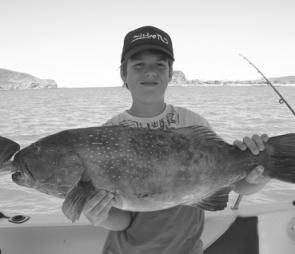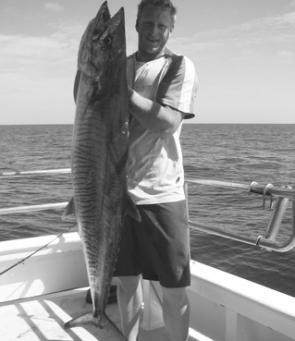Bring on the cooler months! Everyone needs a break after the unusually warm summer and its rotten run of weather. High water temperatures and late cyclones did very little to keep the offshore fishers happy but that all pales in comparison to Larry’s devastation up north.
Innisfail and Babinda have begun long rebuilding process and should slowly be getting closer to the return of some normalcy. For those of us who weren’t affected as severely, May should see the beginning of calmer days making the wider locations that much more accessible.
Coral trout have continued to be common captures as autumn progresses. Some of the trout caught appear to have come from the remote regions rather than the islands. A number of coral trout have been scored on poppers in shallow water between rocks and coral lumps. Right around the Keppels there are lots of shale type rock structures that trout prefer.
The best depth to fish is from 15-20m. It doesn’t matter if you’re fishing baits or lures as long as you get them down within eyesight of the fish.
Last year, around this time, we received a big run of undersize red emperor in close to the main Keppel group and in many of the closer rubble patches and shallow reefs around 20m or more. This year, so far, quality 55cm+ reds have been providing an excellent meal for a couple of people. These small reds are by far the best eating of all the redfishes. Like their bigger brothers they will chew on a wide variety of baits and can be quite stubborn fighters. Reds like fresh flesh baits, squid, prawns and live herring or hardiheads won’t last 5 minutes. Barren and Child, Man & Wife, Outer, Liza Jane and Humpy all have a reasonable populations that hang along the drop-offs and nearby rubbly locale. This is probably going to be the last season in close for this mob before they head out to deeper areas.
Spanish schools are passing through the Yeppoon area in spurts, but the local population remains at Barren and Cape Manifold. There are always differing opinions on whether or not these are home fish. I think anytime that you can nail a Spaniard when the schools aren’t here means they’re a home fish.
Down riggers and trollheads always come into their own by reaching fish that hang deeper. The fussier home Spanish mackerel will cruise in and check out a bait before grabbing rather than tear in and smash it when there is feeding competition. Home Spaniards are never really big fish, but for unknown reasons they have been mostly large so far this year.
Dog and grey mackerel should be coming into the bay soon providing we get some quiet days weather wise.
Black jew thrive in the cooler months. Four days before and after the full moon is the accepted rule for jew in shallow water.
The Double Heads and Corio Heads jewholes will come on as the water temperature drops in May. You can get black jew from the deeper spots on any night-time outing. The Pinnacles, Cape Capricorn and Double Rocks are the better deep spots.
If you’re after black jew use squid, pilchards, bonito fillets and ribbonfish slabs as bait.
Barra catches should become more common in winter as anglers fish the large impoundments that grow these huge specimens. Central Queensland anglers tend to avoid saltwater barra once the water temperatures drop, but you might catch the odd one on a rare, warmer day.
Based on last year’s results, impoundment fish appear to have a wider scope of feeding times and temps. Warmer days will work better when the shallow edges heat up and trigger a chew. Summer’s deep divers will go to the back of the box and the big shallow divers will come out as the water temp cools.
A couple of my impoundment angler mates believe that standard lures need some tweaking to get them to stay in the zone longer. They drill small holes in the bottom of the lure behind the bib or in the middle depending on the attitude of the lure and then experiment by adding tiny split shots until they get it to neutral buoyancy. Once they’re happy they fill the hole with araldite and seal it again. Most of the better quality shallow divers pop to the surface too quickly, and this solves the problem. The action does slow with the weight, so you can jig them a bit more and they won’t float up.
Small numbers of full bucks have been recorded recently in the areas estuaries. The rain will have sent them on another feeding drive, which bodes well for the rest of April and early May.
Prawns did an about face as soon as the wind changed from southeast to northeast and came on for a couple of days in Rosslyn Bay Harbour and Statue Bay. We might get another run before winter sets in.
Coorooman Creek is just starting to fire with its regular May whiting run. The sandbars at the mouth are a prime location to find decent whiting and from April to May they gather in quantity. Yabbies will work best, beachworms and prawns should also produce well.
The schools move about and it’s often hard to pick the spot first off. Drift until you find them and then drop small amounts berley to keep them around. Chopped yabbies, prawn shells and worms mixed with handfuls of sand should entertain them until you have enough for a feed.
I think it’s a waste to use whiting fillets as salmon bait, but the old blokes from Coorooman swear by it. When salmon aren’t in full feeding mode they say whiting fillets can turn your luck around, particularly when the whiting schools are here.
Reads: 1637
Peter Mills with a Keppels coral trout.

Shane Findlay scored this Spanish mackerel at the Keppels.




